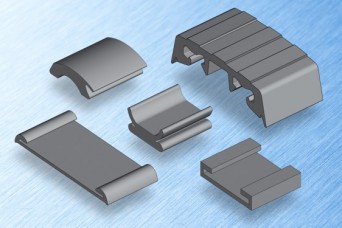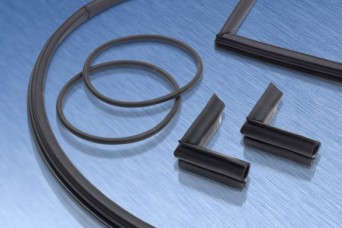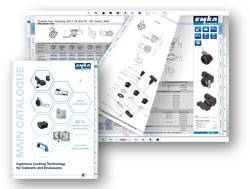By Andy Billingham, Managing Director – EMKA (UK) Ltd
Choosing a sealing profile does not have to involve choosing the material as there are many standard sections in standard rubbers found to be suitable for general purposes such as control cabinet door sealing, where specification may be made primarily on the correct mechanical fit. Even so it certainly helps to have a basic understanding of the raw materials and their compounding especially as performance in long term service can be significantly affected by material selection even in less arduous installations. We aim here to give some insight into the make-up of the materials themselves with general indications of likely suitability.

Rubber Types:
The most common chemical elements in rubber are carbon (C) and hydrogen (H). The polymers of natural rubber are mainly built of these elements. In synthetic rubber these elements are products from the petrochemical industry.
Natural rubber (NR) – production and properties
The rubber tree grows in tropical climates and is cultivated in many countries. The biggest producers are Thailand, Indonesia and Malaysia, which combined produce 80% of world consumption. Plantations can also be found in South America and Africa. When tapping the tree, a cut is made through the bark and the latex drips down into a cup.
A tree with a good yield can give 30-35 grams of rubber per day. The contents of the cups are emptied into containers and transported to a rubber factory. Acetic acid is added to promote coagulation. To manufacture smoked sheets, the rubber is made into sheets in a mill, washed, dried, smoked and finally classified. With the exception of butadiene rubber, natural rubber has the best elasticity of all rubber types. It has very good resistance to abrasion and fatigue. Among the drawbacks are the material’s poor resistance to ozone (weather) and oils and fuels.
Natural rubber is mainly used in the production of heavy-duty tyres, vibration dampers, springs and bearings. For special purposes it is used in hoses seals, conveyor belts, coated fabrics and other products.
Styrene-butadiene rubber (SBR) – the most common type of synthetic rubber
When the automobile industry developed, demands for rubber increased sharply. Many trials were made to produce a man-made rubber. The first synthetic rubber could not match natural rubber, but in the course of time several rubber types were developed that had many properties comparable with natural rubber, in some cases even better.
Styrene-butadiene rubber, the most common and cheapest synthetic rubber, serves as an example of the manufacturing principles. The basic material is derived from petroleum (oil) which is a fossil formation from organisms that have been dead for millions of years. In the distillation process at the oil refineries, styrene and butadiene are produced, which are then used as raw materials for the production or styrene-butadiene rubber.
The first step is to let styrene and butadiene react together. The new material consists of about 25% styrene, with butadiene making up the remainder. The result is a synthetic rubber that in principle has the same properties as natural rubber. Heat resistance is better but low temperature flexibility and tensile strength are less than for natural rubber. In general, around 60% of the polymers used are synthetic, while 40% is natural rubber.
Styrene-butadiene rubber is used in many of the same products as natural rubber. It is also used to cover different types of hose and in a number of other products. For practical reasons, abbreviations of the various rubber types have been internationally approved. These abbreviations are used in this presentation.
Isoprene rubber (IR) – very much as natural rubber
Isoprene rubber has the same chemical structure as natural rubber (polyisoprene). However, it does not contain proteins, fatty acids and the other substances that are present in natural rubber. The physical properties of isoprene rubber are in general somewhat inferior to those of natural rubber but, in principle, the two types are very alike. Isoprene rubber is used in the same type of products as natural rubber.
Butadiene rubber (BR) – the most elastic rubber type
Butadiene rubber is polymerized butadiene. It is used in blends with other rubber types for improved elasticity, wear resistance and low temperature properties. A typical application is a blend of butadiene rubber and natural rubber in truck tyres.

Special Rubber Types:
The above-mentioned rubber types are so-called general purpose. Many other types are available, each with their own special properties. The most common special types in our products are ethylene-propylene, butyl, chloroprene and nitrile rubber.
Ethylene-propylene rubber (EDM/EPDM) – for many purposes
For manufacture of profiles at high temperatures, ethylene-propylene rubber, with the abbreviation EPDM, is used. The first two letters mean that the rubber consists of ethylene and propylene, but the letter D tells us that a diene is also present. That third monomer makes it possible to cure the rubber with sulphur since it introduces double bonds in the structure, thereby changing the structure to an unsaturated polymer. Since ethylene-propylene rubber does not crack outdoors (good ozone resistance) it is widely used for glazing seals in buildings and in the automotive industry. Steam hoses, high temperature-resistant seals and roll covers are other applications.
Butyl rubber (IIR) – when low gas permeation is needed
Products used to prevent gases from passing through the material are based on butyl rubber. The polymer consists of isobutene with a minor part of isoprene. The isoprene makes the rubber unsaturated and possible to vulcanize. The gas permeability increases with increased temperature for all rubber types, but for butyl rubber it is very low, up to 160-175 F. Tyre inner tubes are made of butyl rubber.
Chloroprene rubber (CR) – resistant to oil and weather
Most chloroprene rubber types consist solely of polymerized chloroprene monomers. The polymer has a good resistance to the outdoor climate and reasonable oil resistance. It is therefore used in profiles and products which may be exposed to oil-based fuels.
Nitrile rubber (NBR) – for use with oil
Nitrile rubber is a copolymer of acrylonitrile and butadiene. It is the most common polymer for products that are in contact with oil and fuel. Nitrile rubber is used in inner tubes for fuel and oil hoses, for example.

Not only rubber:
A rubber compound used for product manufacturing contains much more than a polymer as shown by the following list:
Fillers
Carbon black is used to reinforce the compound. Whiting or clay can be used to extend the compound.
Vulcanising agents
Besides sulphur, accelerators are used to achieve a higher curing rate, and activators contribute to an initiation of the curing process.
Ageing protectors
Antioxidants and antiozonants are used to protect the rubber from oxidation and ozone cracking.
Softeners
To regulate the hardness and improve the processing of a rubber compound, for example, mineral oils, or ester, plasticers are used.
Special ingredients
Pigments in light-coloured compounds, antistatic lubricants to reduce static electricity, blowing agents for sponge rubber, flame retarders to improve non-inflammability, etc.
Reinforcement
To increase mechanical strength, many rubber products are reinforced. Typical reinforcement materials are textile and stamped steel wire and hoses, as well as glass-fibre cord.
Coatings
To reduce friction on the extrudate surface a coating may be introduced, typical coatings are silicone, glycerine, flock and xylan fluoropolymer.
Download “The What, Why and How of Rubber Specifications for Sealing Profiles” as a pdf document



